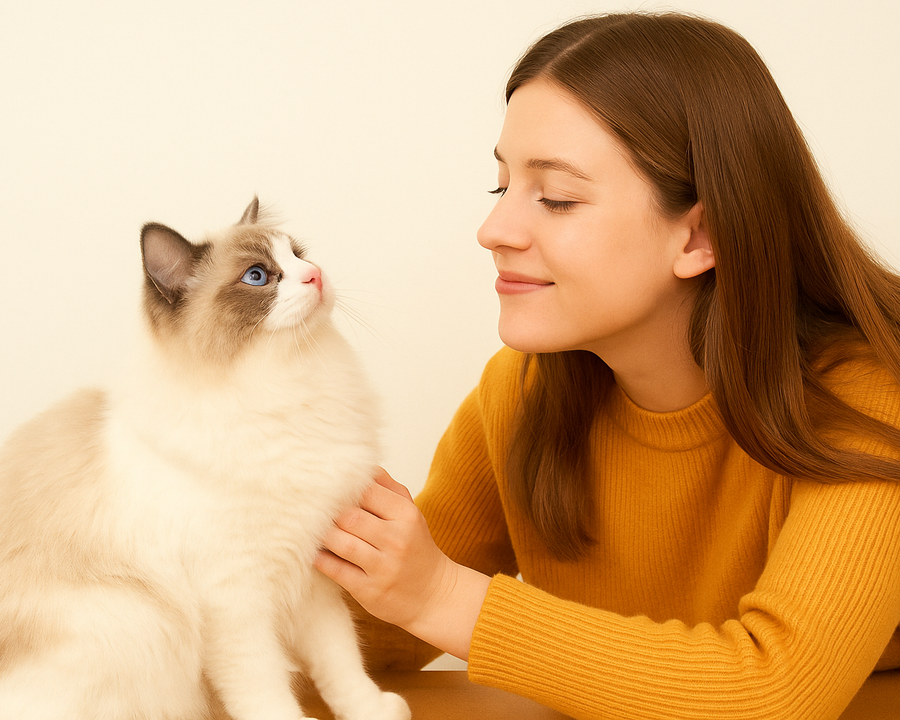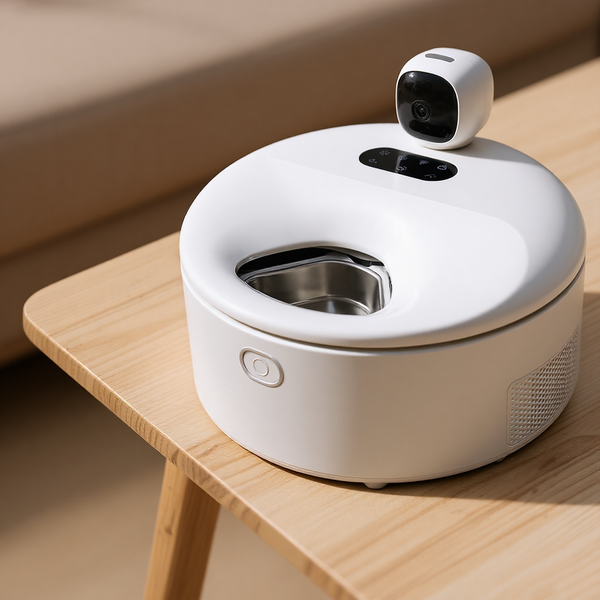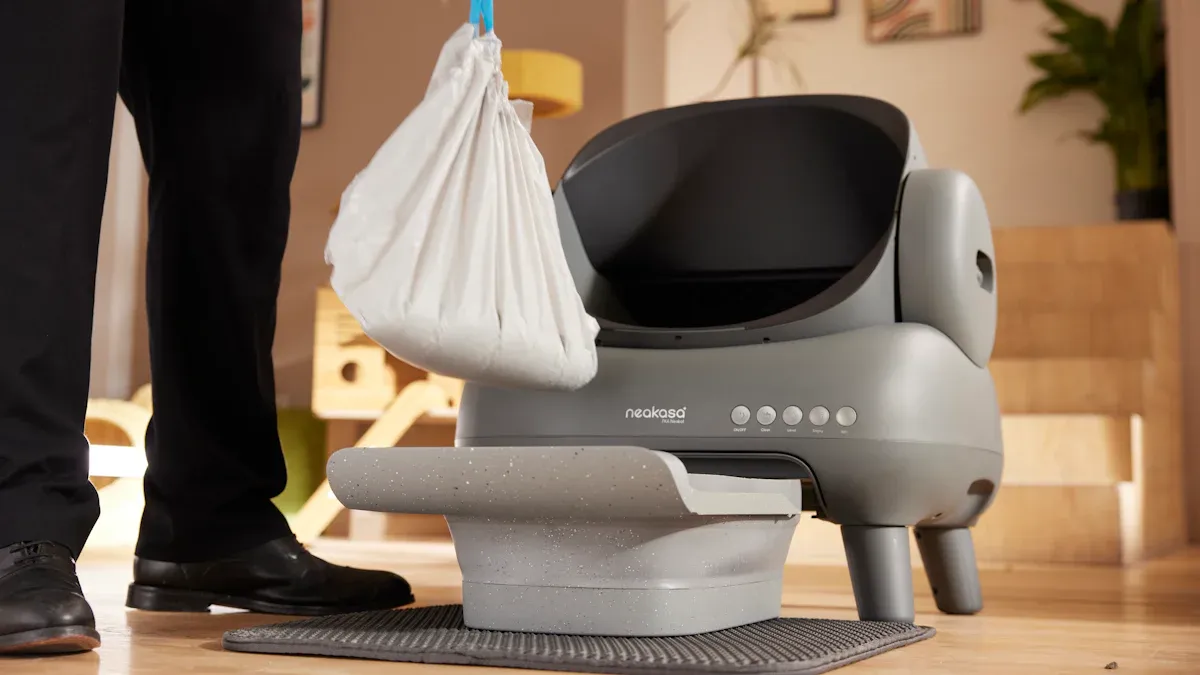
You might wonder if a covered cat litter box with scoop is the right pick for your home. Many pet owners like how these boxes control odor and keep things tidy. They also look good and give your cat some privacy. On the flip side, some cats take time to adjust, and you may notice issues with ventilation or how easy it is for your cat to get in. Think about what works best for your cat and your space before making a choice.
Key Takeaways
-
Covered litter boxes give your cat privacy. This helps your cat feel safe and secure when using the box. These boxes help control smells well. Your home will smell fresh if you clean the box often. Pick the right size and entry for your cat. This makes sure your cat is comfortable and can use the box easily. Clean the box often. Scoop every day and wash the box every week to keep it clean. Watch how your cat acts to see if a covered box works. Some cats may like open boxes better.
What Is a Cat Litter Box with Scoop?
Covered vs. Open Boxes
When you look for a Cat Litter Box with Scoop, you will see two main types: covered and open. Each type has its own benefits and drawbacks. Here’s a quick comparison to help you decide which might work best for your cat and your home:
|
Feature |
Covered Litter Boxes |
Open Litter Boxes |
|---|---|---|
|
Privacy |
No privacy, may stress shy cats |
|
|
Odor Control |
Traps odors inside, but needs good airflow |
Smells escape faster, but air circulates |
|
Ease of Use |
Can feel tight for big or older cats |
Easy for all cats to enter and exit |
|
Aesthetic |
Hides litter and waste from view |
Litter and waste are visible |
Tip: If your cat likes quiet spaces, a covered box may help them feel safe. If your cat is large or older, an open box might be easier for them to use.
Key Features
A Cat Litter Box with Scoop often comes with smart features that make life easier for you and your pet. Here are some of the most common features you will find:
|
Feature |
Description |
|---|---|
|
Self-Cleaning |
Cleans itself, so you scoop less |
|
Odor Control |
Keeps smells inside, up to 5x better |
|
Dust-Free |
Reduces dust, which helps with allergies |
-
The enclosed design keeps dogs and small children out of the litter.
-
You get better odor control, which means your home smells fresher.
-
Many boxes come with a scoop that fits neatly inside or on the side, so you always know where it is.
A Cat Litter Box with Scoop can make cleaning up after your cat much simpler. You spend less time worrying about mess and more time enjoying your pet.
Cat Litter Box with Scoop: Pros
Odor Control
You want your home to smell fresh, even with a cat around. A Cat Litter Box with Scoop helps you keep odors in check. Covered boxes trap odor particles inside, so you notice fewer smells in your living space. Some models use carbon filters or sealed drawers to boost odor control. Take a look at what studies found:
|
Study Reference |
Findings |
|---|---|
|
Litter-Robot Blog |
Covered litter boxes help contain odor particles better than open boxes. |
|
Litter-Robot Blog |
Sealed drawers and carbon filters reduce odors in the home. |
Tip: If you use odor-eliminating accessories, you can make your Cat Litter Box with Scoop even more effective.
Less Litter Tracking
Nobody likes stepping on stray litter. Covered boxes help keep litter inside, so you spend less time sweeping. When your cat digs or kicks, the walls block most of the mess. You also see less dust in the air, especially if you use low-dust litter.
-
Covered boxes stop litter from being kicked or scattered outside.
-
They limit how much litter escapes, so you only see small amounts near the opening or on your cat’s paws.
-
Dust stays inside, which helps if you have allergies.
Note: Choosing a covered Cat Litter Box with Scoop means you get a cleaner floor and less mess around the box.
Tidy Appearance
You want your home to look neat, even with pets. Covered litter boxes hide waste and litter from view. They blend in with your furniture and decor, so guests may not even notice them. The area around the box stays cleaner because litter doesn’t get kicked out.
-
Covered boxes look tidier and fit better with your home style.
-
They help keep the surrounding area clean and free of scattered litter.
Callout: If you care about how your home looks, a covered box is a smart choice.
Cat Privacy
Cats like privacy when they use the litter box. A covered Cat Litter Box with Scoop gives your cat a quiet, enclosed space. Shy cats feel safer inside, and they may use the box more often. You also get fewer accidents outside the box because your cat feels comfortable.
-
Covered boxes offer a private spot for your cat.
-
Shy or anxious cats often prefer an enclosed space.
-
You may see better litter box habits with more privacy.
Tip: If your cat seems nervous or hides often, try a covered box to help them relax.
Cat Litter Box with Scoop: Cons
Ventilation Issues
Covered litter boxes can trap smells inside. The enclosed design restricts airflow, so odors and moisture from your cat’s waste build up faster. You might notice a damp feeling or a stronger smell when you open the box. Open litter boxes let air move freely, which helps keep things dry and fresh. If you use a covered box, you may need to clean it more often or use extra odor control products.
Tip: Try to place the box in a well-ventilated area to help with airflow.
Cat Comfort
Not every cat likes a covered box. Some cats feel trapped or nervous inside an enclosed space. Others may not care at all. Studies show that about 70% of cats do not have a strong preference between covered and open boxes. Of the rest, 15% like covered boxes, and 15% prefer open ones. Your cat’s comfort matters most, so watch how they act when you introduce a new box.
-
70% of cats show no preference between covered and uncovered boxes.
-
15% prefer covered boxes.
-
15% prefer open boxes.
If your cat avoids the box or seems stressed, try switching to a different style.
Cleaning Challenges
Cleaning a covered litter box can feel like a chore. You have to remove the lid every time you scoop. Sometimes, you might miss messes because the cover hides them. If you skip cleaning for a day or two, the smell and mess can get worse. Many owners find that cleaning a covered box can be overwhelming, especially if it has not been done in a while. Litter can still get tracked outside, so you need to sweep around the area. Setting a regular cleaning routine helps, but it takes effort to keep things fresh.
-
Cleaning can feel overwhelming if you wait too long.
-
Litter may still get tracked outside the box.
-
Covered boxes can hide messes until they become bigger problems.
Note: Make a habit of checking and cleaning the box daily to avoid surprises.
Accessibility
Covered boxes sometimes have high entry points. Older cats or cats with arthritis may struggle to get in and out. If your cat has trouble moving, look for a box with a lower entry. Traditional designs do not always work for cats with physical challenges. Using shallow litter, about one and a half inches deep, can help your cat move around more easily. Step-out mats with absorbent pads can also help if your cat has trouble squatting low.
-
Lower entry boxes are better for cats with mobility issues.
-
Shallow litter makes it easier for your cat to move.
-
Step-out mats help manage accidents outside the box.
If you notice your cat having trouble, consider switching to a more accessible option.
Choosing the Right Box
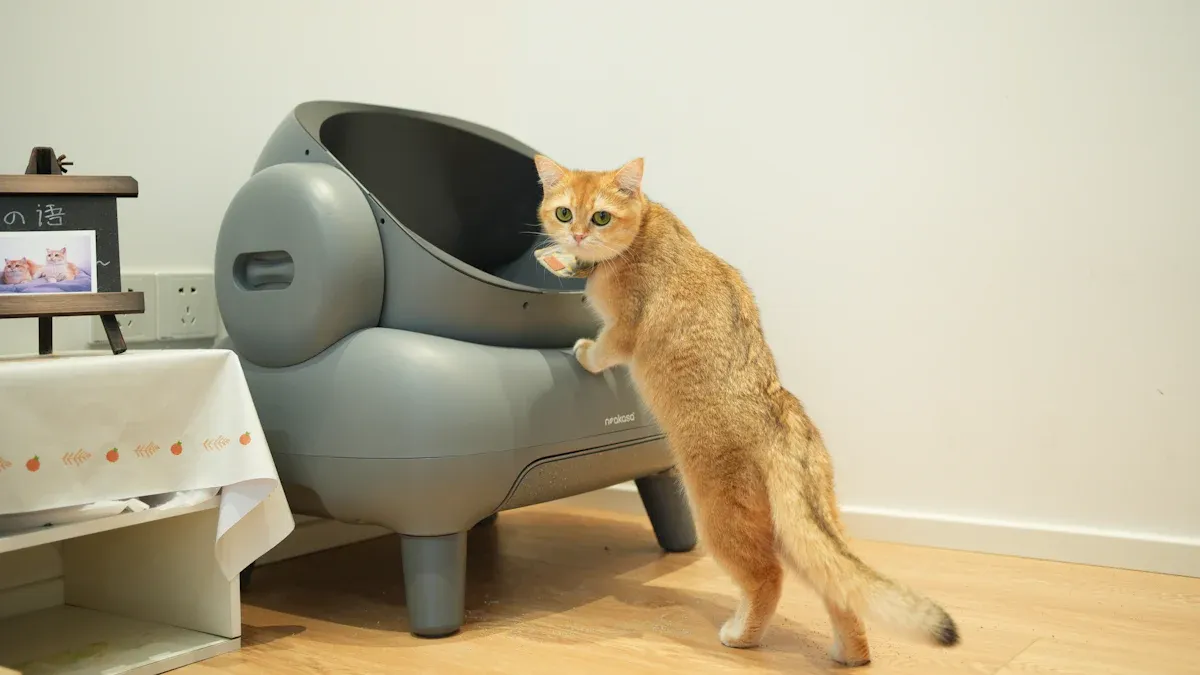
Size and Entry
Picking the right size matters more than you might think. If you have a big cat, like a Ragdoll, you need a spacious box. Small boxes can make your cat feel cramped, and that might lead to litter box aversion. Watch how your cat moves and uses their box. Some cats like to turn around and dig, so extra room helps.
When it comes to entry, side-entry boxes are usually easier for most cats. Top-entry boxes can be tough for kittens, seniors, or cats with arthritis. Large or overweight cats may also struggle with top-entry designs. If your cat avoids the box or has accidents, try switching to a side-entry style.
-
Large breeds need roomy boxes.
-
Senior cats and kittens do better with low, side-entry boxes.
-
Cramped boxes can cause your cat to avoid using them.
Material and Durability
You want a box that lasts. Look for sturdy plastic or eco-friendly materials. Some boxes have antimicrobial coatings to help with hygiene. Durable boxes stand up to scratching and digging. If you have more than one cat, choose a box that can handle extra use.
Cleaning is easier with smooth surfaces. Wipe the edges every few days and wash the box with mild soap when you change the litter. Replace all litter every 2-3 weeks, or more often if you have multiple cats.
|
Maintenance Task |
Frequency |
|---|---|
|
Scoop litter |
At least once or twice daily |
|
Wipe edges with pet-safe wipe |
Every few days |
|
Replace all litter |
Every 2-3 weeks |
|
Wash the box with mild soap |
As needed |
Scoop Design
A good scoop makes cleaning faster and easier. Wide-tine scoops sift debris well, especially in gravel or sandy litter. Claw-style scoops work great on hard surfaces. Flat-jaw scoops grab messes in one smooth motion. Non-stick surfaces help you clean up without hassle.
Some scoops have swivel-bin features, which let you move around obstacles. High-capacity trays are perfect if you have more than one cat. If you care about hygiene, look for scoops with antimicrobial coatings. Eco-friendly options are available too.
-
Wide-tine and debris-sifting scoops for easy cleaning.
-
Claw-style and flat-jaw scoops for quick waste removal.
-
Non-stick and antimicrobial features for better hygiene.
Placement Tips
Where you put the box makes a big difference. You should have one box per cat, plus one extra. Spread them out in different rooms, especially if you have more than one cat. Keep boxes away from food and water bowls. Avoid noisy spots, like near washing machines.
Put a box on each level of your home so your cat can reach it easily. Clean the box at least twice a day. Privacy matters, but make sure your cat can get to the box without trouble.
-
One box per cat, plus one extra.
-
Place boxes in quiet, accessible spots.
-
Keep food and water separate from the litter box area.
Tip: Choosing a quality product shows you care about your pet’s comfort. Petcantalk offers smart feeders, customizable care packages, and preventive care plans. Their commitment to pet satisfaction helps you give your cat the best.
|
Feature |
Description |
|---|---|
|
Smart Feeders |
Automated feeding for timely meals. |
|
Customizable Care Packages |
Personalize care based on your pet’s needs. |
|
Preventive Care Plans |
Regular health checkups and dental cleanings. |
|
Community Features |
Connect with other pet owners for support and shared experiences. |
Alternatives to Covered Boxes
Open Litter Boxes
Open litter boxes give cats lots of room. Cats can get in and out easily. You can see when the box is dirty. This helps you clean it often. Cats who do not like tight spaces may choose open boxes. Here is how open boxes and covered boxes compare:
|
Feature |
Covered Litter Boxes |
Open Litter Boxes |
|---|---|---|
|
Privacy |
Gives a private spot for shy cats. |
No privacy, which can bother timid cats. |
|
Odor Control |
Holds smells inside but can trap odors. |
Good airflow lowers strong smells. |
|
Space |
May feel small for big or old cats. |
Lots of space for comfort and movement. |
|
Visibility of Mess |
Hides mess, which some owners like. |
Mess is easy to see and needs more cleaning. |
|
Accessibility |
Some cats find it hard to get in or out. |
Easy for cats to use all the time. |
Tip: Older cats or cats with trouble moving do better with open boxes.
Top-Entry Boxes
Top-entry boxes look stylish and keep litter inside. You scoop from the top. Cats jump in through a hole in the lid. These boxes stop most litter from getting out. Your floors stay cleaner. Cats who dig a lot like the deep space. Here is how top-entry boxes and covered boxes compare:
|
Feature |
Top-Entry Box |
Covered Box |
|---|---|---|
|
Odor Control |
High walls help keep smells low. |
Can trap odors inside the box. |
|
Litter Tracking |
Stops litter from spreading far. |
May let more litter escape. |
|
User Preference |
15% of cats like covered boxes best. |
-
Most cats do not mind either style.
-
Top-entry boxes are good if you have dogs or small kids.
Callout: If you want less mess and a modern look, try a top-entry box.
Self-Cleaning Options
Self-cleaning litter boxes save you time. These boxes use sensors or timers to scoop waste. You do not need to clean as often. Your cat always has a clean spot. Special litter helps trap smells and means you change it less.
|
Feature/Benefit |
Self-Cleaning Litter Boxes |
Covered Boxes with Scoop |
|---|---|---|
|
Convenience |
Cleans itself, so you do less work. |
You must scoop by hand often. |
|
Hygiene |
Always stays clean for your cat. |
Waste can build up between cleanings. |
|
Odor Control |
Uses crystal litter to trap smells. |
Can smell bad if not scooped often. |
|
Frequency of Litter Changes |
Change litter less often. |
Change litter more often. |
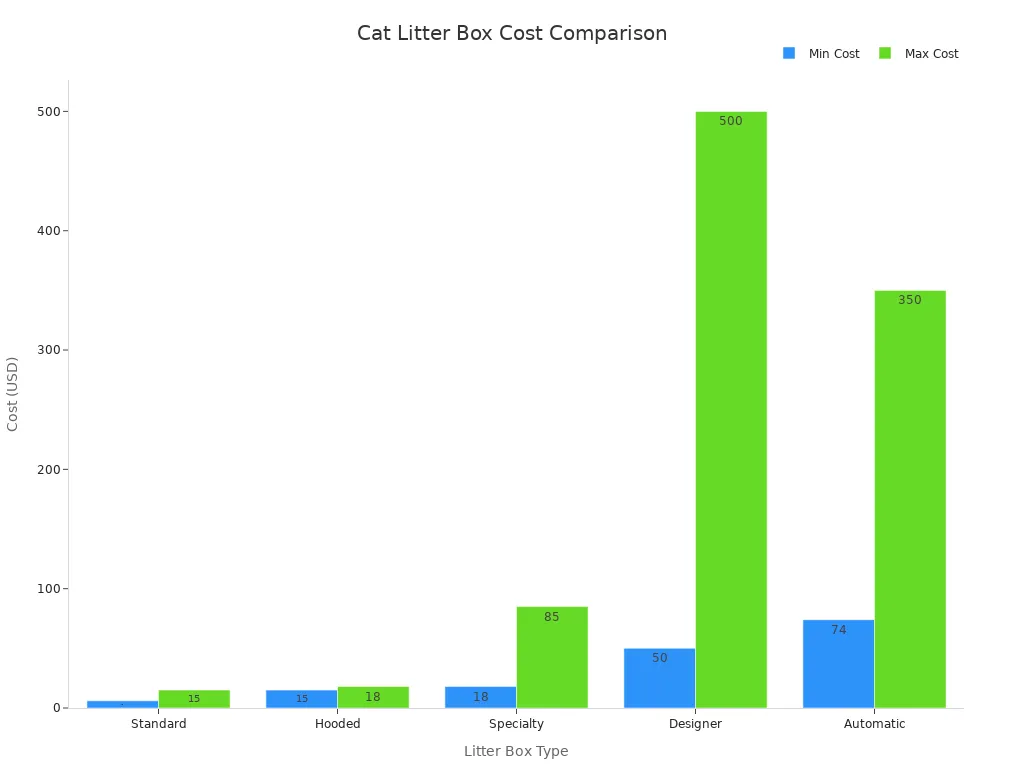
Note: Self-cleaning boxes cost more at first, but you spend less time cleaning.
Popular features to consider when choosing an alternative:
-
Size & Space
-
Entry & Exit Points
-
Ventilation
-
Ease of Cleaning
-
Odor Control
-
Material & Durability
-
Privacy vs. Transparency
-
Litter Scatter Prevention
-
Aesthetic
-
Additional Features
There are many choices for litter boxes. Pick the one that matches your cat’s needs and your cleaning habits.
Choosing a covered cat litter box with scoop has clear benefits like privacy and odor control, but you might notice cleaning challenges or ventilation issues. Your cat’s comfort matters most. Research shows cats care more about box size and litter type than the box style.
|
Pros |
Cons |
|---|---|
|
Odor control |
Ventilation issues |
|
Tidy appearance |
Cleaning challenges |
|
Cat privacy |
Accessibility concerns |
-
Watch your cat’s behavior when you introduce a new box.
-
Pick a box that fits your cat’s size and habits.
-
Clean often and place boxes in quiet spots.
The best choice depends on your cat’s needs and your home. Keep things simple and observe what works for both of you.
FAQ
Can my cat use a covered litter box right away?
Most cats try a new box quickly. If your cat seems unsure, leave the lid off for a few days. Watch how your cat acts. You can add the cover later if your cat feels comfortable.
How often should I clean a covered litter box?
You should scoop waste at least once a day. Wash the box with mild soap every week. If you have more than one cat, clean more often. A clean box keeps your cat happy.
Do covered litter boxes really control odor better?
Yes, covered boxes trap smells inside. You notice fewer odors in your home. For best results, use odor-control litter and clean the box often. Some boxes have filters for extra help.
What if my cat stops using the litter box?
Check the box size and entry. Make sure the box is clean. Try switching to an open box if your cat avoids the covered one. Cats like clean, easy-to-reach boxes.



